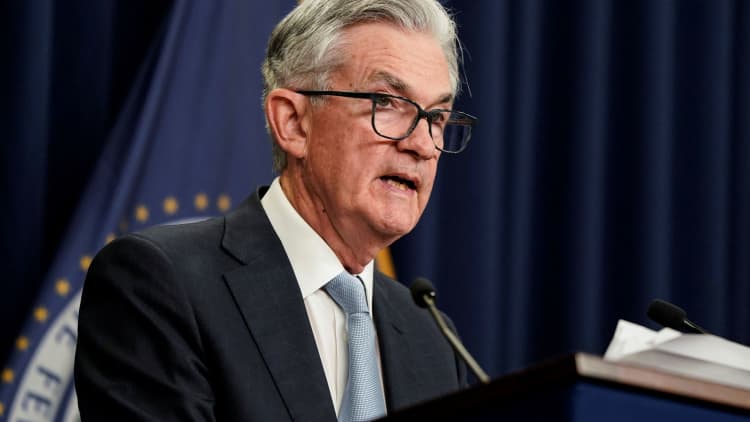[ad_1]

The Federal Reserve is expected to announce its eighth consecutive rate hike at this week’s policy meeting.
This time, Fed officials are likely to agree to a 0.25 percentage point hike as inflation begins to moderate, a more modest pace compared to previous super-sized moves in 2022.
Still, the increase in the benchmark interest rate means that borrowers are paying even more interest on credit cards, student loans and other loans. On the other hand, savers could benefit from higher returns.
More about Personal Finance:
What is a ‘moving recession’ and how does it affect you?
Almost half of Americans think we are already in a recession
If you want a higher salary, your chances may be better now
“The good news is that the worst is over,” said Yiming Ma, an assistant professor of economics at Columbia University Business School.
The US Federal Reserve is now on its knees in a rate hike cycle, having raised its key rate by 4.25 percentage points in less than a year.
While inflation remains above the Fed’s long-term target of 2 percent, price pressures have “reduced significantly and the pace of rate hikes is slowing,” Ma said.
The good news is that the worst is over.
Yiming Ma
assistant professor of economics at Columbia University Business School
The goal is to further contain the runaway inflation by increasing borrowing costs and to brake the economy effectively.
What the Fed’s rate hike means for you
The federal funds rate, set by the central bank, is the rate at which banks borrow and lend to each other overnight. Higher Fed interest rates directly or indirectly affect consumers’ borrowing costs and, to a lesser extent, the interest they earn on their savings accounts.
Here’s a breakdown of how it works:
Plastic
Since most credit cards have variable interest rates, they are directly linked to the Fed’s benchmark index. When the federal funds rate rises, so does the prime rate, and credit card rates follow suit. Cardholders usually see the impact within one or two billing cycles.
After rising at the steepest annual rate ever, the average credit card interest rate now averages 19.9%, an all-time high. In addition to the fact that the central bank is committed to raising its benchmark index to combat inflation, annual interest rates on credit cards also continue to rise.
Households rely more and more on loans to obtain basic needs, as incomes have not kept pace with inflation. This makes it even more difficult for the growing number of borrowers who carry a balance each month.

“Credit card balances are rising while credit card interest rates are at record highs; that’s a bad combination,” said Greg McBride, chief financial analyst at Bankrate.com.
If you currently have credit card debt, tap into a low-interest personal loan or 0% balance transfer card and don’t put extra purchases on credit unless you can pay off the balance in full at the end of the month and even put money aside, McBride advised.
Home loans
While 15- and 30-year mortgage rates are fixed and tied to Treasury yields and the economy, anyone buying a new home has lost significant purchasing power, due in part to inflation and Fed policy moves.
“Despite what is most likely to be a hike by the central bank, mortgage rates may actually stay close to where they are in the coming weeks, or even continue to decline slightly,” said Jacob Channel, senior economist at LendingTree.
The average rate for a 30-year fixed-rate mortgage is currently 6.4 percent, down from a peak of 7.08 percent in mid-November.
Still, “these relatively high prices, combined with persistently high home prices, mean that buying a home remains a challenge for many,” Channel added.
Adjustable-rate mortgages, or ARM loans, and home equity loans, or HELOC credit agreements, are tied to the prime rate. When the federal funds rate rises, so does the prime rate, and these rates follow suit. Most ARMs adjust once a year, but a HELOC adjusts immediately. Even now, the average share of a HELOC is up to 7.65%, compared to 4.11% a year ago.
Car loans
Although car loans are fixed, payments increase because the price of all cars increases with the interest on new loans. So if you are going to buy a car, you will pay more in the coming months.
The average interest rate for a five-year new car loan is currently 6.18%, while it was 3.96% at the beginning of 2022.
Boonchai Wedmakawand | A moment | Getty Images
“Increased pricing combined with frequent rate hikes continue to increase monthly loan payments,” Thomas King, JD Power’s director of data and analytics, said in a statement.
Car buyers with higher credit scores can get better loan terms or find better pricing on some used car models.
Student loans
Interest rates on federal student loans are also fixed, so the rate hike will not immediately affect most borrowers. The federal student loan interest rate for the 2022-23 academic year has already risen to 4.99 percent from last year’s 3.73 percent and from 2.75 percent in 2020-21. Loans paid after July 1 are likely to be even higher.
Private student loans usually have variable interest rates that are tied to Libor, prime, or the Treasury bond rate — meaning that when the central bank raises interest rates, borrowers also pay more in interest. However, how much more varies depending on the benchmark.
For now, anyone with federal education debt will enjoy 0 percent interest until the end of the grace period, which the Department of Education expects to happen sometime this year.
Savings account
On the other hand, some savings accounts have higher interest rates after interest rate hikes.
Although the Fed has no direct influence on deposit rates, rates are generally correlated with changes in the target federal funds rate. Interest rates on savings accounts at some of the biggest retail banks, which were near rock bottom for most of the Covid pandemic, are currently averaging 0.33%.
Guido Mieth | DigitalVision | Getty Images
Thanks in part to lower overhead costs, high-yield online savings accounts have interest rates as high as 4.35%, much higher than the average rate at a brick-and-mortar bank, according to Bankrate.
“If you shop around, you’ll get the best returns since the Great Recession. If you don’t shop around, you’ll still make next to nothing,” McBride said.
Still, any money that earns less than inflation loses purchasing power over time, and more households tend to have less set aside.
“The best advice is to pick up a side business for extra income, even if it’s only temporary, and pay yourself first by direct depositing into your savings account,” McBride advised. “That’s how you’re going to create a path for you to save.”
Subscribe to CNBC on YouTube.
.
[ad_2]
news.google.com